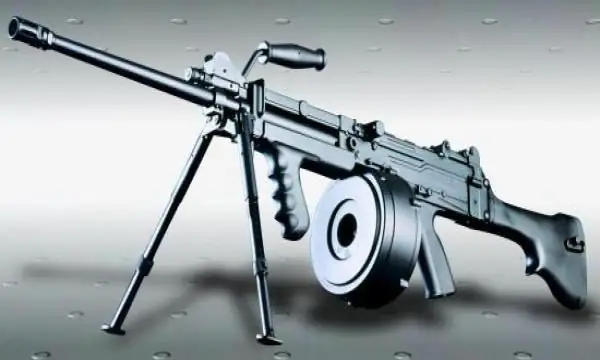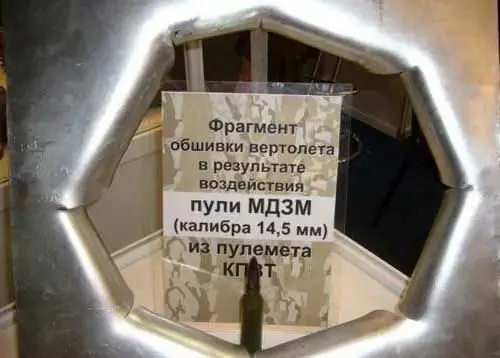2026 Author: Howard Calhoun | [email protected]. Last modified: 2025-06-01 07:12:56
7, 62-mm machine gun Goryunov (SG-43) is a Soviet automatic small arms model 1943. Mounted on wheeled machines, swivel and armored vehicles.
What can replace "Maxim"?
By the beginning of World War II, the problem of creating an infantry support weapon at the battalion level - an easel machine gun - could not be solved. The Maxim, which was in service with the Red Army, had a number of significant shortcomings, which it was not possible to overcome. The main one was the impressive weight of the easel machine gun - in the equipped state, that is, filled with water and loaded, its mass was 63 kg. The water cooling of the Maxim did not add any convenience, since it is often difficult, if not impossible, to find water in combat conditions. In addition, fragments and bullets easily damaged the casing, making it unusable.
The initial plans to replace the Maxim machine gun with the DS-39 model were not implemented, because the weapon turned out to be difficult to manufacture and operate, unreliable at low temperatures and dustiness. As a result, the DS-39 was discontinued.

GVG Modification
In May 1942, the development of a new machine gun design for a 7.62-mm cartridge began. Here the GVG came in handy, which in 1940 was successfully tested at the factory.
The Goryunov light machine gun was developed at the Kovrov Mechanical Plant by Pyotr Maksimovich Goryunov, his nephew Mikhail, and also by the factory foreman Vasily Voronkov. According to the first letters of these surnames - GVG - the weapon was named.
But the Red Army demanded an easel version, and Goryunov adapted the machine gun to perform new tasks.

Successful trials
After the completion of factory tests at the end of 1942, the upgraded version was made in the amount of 50 pieces, 45 of which were sent to the troops. The results were also positive. After eliminating the comments and identified shortcomings in the late spring of 1943, the Goryunov machine gun participated in state tests. The main competitor of the GVG was the modernized DS-43, as well as weapons made in Germany, since the option of reworking the German MG-34 chambered for the Mosin rifle with its subsequent adoption by the Red Army was seriously considered. However, it turned out that it was impossible to use a Soviet rifle cartridge in it due to the presence of a rim. Goryunov's easel machine gun has many times surpassed the captured samples and the DS-43 in such important parameters as durability and accuracy of fire.
After reading the test results, Degtyarev personally assured Stalin of the superiority of the Goryunov model and the need to adopt it. In addition, the designer created a new machine for a competitor, which began to be producedalong with new weapons.

Begin production
14.05.43 The State Defense Committee decided to adopt the Goryunov machine gun (photo is given in the article) with a wheeled machine. For its manufacture at the Kovrov Mechanical Plant, a separate workshop was built in two and a half months. In the fall of 1943, the first batch of weapons was produced, and the following year, production was expanded by the facilities of the Zlatoust plant No. 54.
At the same time, the developers Seleznev and Garanin designed a simpler wheeled machine that had better performance when working in difficult conditions.
In total, before the end of the war, more than 80 thousand Goryunov machine guns were produced and transferred to the Red Army.

Working principle
The weapon uses the energy of powder gases removed from the barrel channel. Blocking of the latter is done by right-side skew of the shutter.
During the shot, the flow of powder gases is partially redirected through the barrel hole into the gas chamber and presses on the piston, which retracts the bolt carrier. Until the moment the bullet exits, the bolt does not move, blocking the barrel and preventing gases from escaping into the box.
After the bullet leaves the barrel, the moving parts of the machine gun continue to move backward, compressing the spring. The bolt then unlocks the stem channel; the cartridge case is removed from the chamber. Ammunition from a metal or canvas tape enters the barrel box window. From hershells are ejected. With the help of a slide mechanism, cartridges are fed into the tape receiver with a hinged cover that speeds up reloading.
If the trigger is pressed, the bolt frame rushes forward under the action of the spring, without remaining in the rearmost position. The shutter pushes the cartridge out of the receiver window and sends it into the chamber. The moving parts reach the limit position; the shutter blocks the stem channel. The upper protrusion of the bolt carrier hits the firing pin, firing from the rear sear. The process then repeats.
The reload handle protrudes from below under the control sticks and remains stationary when firing.
Adjustment of automatic weapons is carried out by a three-position gas regulator. Air cooling allows for 500 rounds of continuous firing. In normal mode, shooting is carried out in short bursts of up to 30 shots. The Goryunov SG-43 easel machine gun has a rate of fire of 250-300 rounds per minute. The interchangeable barrel has a flash hider and a handle, which makes it easy to carry and replace, the time of which does not exceed 7-8 s.

Ammunition
Shooting is done with bullets arr. 1908 and 1930, which retain their lethal force for the entire flight at a distance of up to 3800 m. The energy of a steel bullet in 1908 is 3511 J, and in 1930 - 3776 J.) type DS-39 or canvas from Maxim, 200 pcs. with right hand feed. Although high feed rates were sometimes accompanied by transverse shell ruptures, theyoccurred much less frequently than with the Degtyarev machine gun.
Guidance system
Sights of the SG-43 include a pin sight and a folding sight. The latter includes a base, a clamp with a whole and a frame with a spring. There are two scales on the frame. The left one is intended for cartridges with bullets of 1908 and allows you to set a distance of up to 2 thousand meters. It is indicated by the letter “L” and the numbers 0-20. The right scale is intended for a cartridge with a 1930 bullet and allows you to set a distance of up to 2.3 thousand meters. It is marked with the letter “T” and numbers 0-23. There is a risk on the rear sight. To install it, the back of the clamp on both sides of the main risk is marked with five divisions of lateral amendments. One mark corresponds to a thousandth of the range.
The machine gun of the Goryunov system is verified by firing at a verification target cut off along the 4th horizontal line, as well as at a black rectangle measuring 20x30 cm on a white shield 1x1 m. The range is set to 100 m, the sight is set to 3 on the left scale, and light bullet cartridges are used.

Anti-aircraft sight
Targets in the air are tracked with the help of an additional anti-aircraft foreshortening sight installed on the Goryunov, designed for air targets at a distance of no more than 1 kilometer, which move at a speed not exceeding 600 km/h. The sight has front and rear sights and a base. The front one is made up of four concentric rings with a radius of 20-80 mm with a step of 20 mm, the purpose of which is to select the lead. ExceptIn addition, the sight in the center has a ring that serves for adjustment, as well as a stand. The back is made up of a ball, a locking calibration screw and a stand. A distinctive quality of the sight is the installation of both sights on the frame, connecting them into a single structure, which ensures the constancy of its settings: it can be repeatedly removed, folded and reinstalled without disturbing the settings.

Use in combat
The Goryunov machine gun entered service in the spring of 1943. The rifle battalions received weapons in the early summer of that year. It was used to destroy open groups of manpower and enemy fire weapons at distances up to 1 km.
The success of "Goryunov" in the battles of the final period of the war is due to its low weight: it is 6.5 kg lighter than "Maxim", and with a wheeled machine - 25 kg.
After World War II, the machine gun was modernized and renamed SGM ("M" - modernized). The dust protection and barrel cooling system was improved, and a new breech was installed. A tank version of the SGMT appeared.
Key Features
The main parameters of the machine gun are:
- Weight: 13.5 kg.
- Machine weight: 23.4 kg.
- Length: 1140 mm.
- Barrel length: 720 mm.
- Firing range (L/T): 2000/2300 m.
- Bullet speed (L/T) W 865/800 m/s.
- Rate of fire: 700 rds/min
- Rate of Fire: Max. 350 rounds/min.
SG-43 was widely exported, licenses were issued for its production in several countries. In China, Goryunov was produced under the name Type 53, in Czechoslovakia - as Vz 43, in Poland (Wz 43) and in South Africa (SS-77).
Recommended:
NSVT heavy machine gun: overview, characteristics and description

Machine guns at the time of their appearance were not accidentally classified as artillery: the power of such weapons still amazes. Moreover, heavy "machine gunners" allow even mounted shooting, so that they can be attributed to artillery systems, albeit with tension, even today
Diesel gun: reviews and selection criteria. Diesel gun of indirect heating: technical characteristics

The diesel heat gun is ideal for quickly heating a construction site, agricultural, warehouse or industrial premises. Since its operation is carried out on diesel fuel, it consumes electricity exclusively for the operation of automation and a fan. As the main advantages of such a technological solution, one can name a relatively high thermal power with rather small dimensions
Large-caliber anti-aircraft machine guns - specifications and photos

Anti-aircraft machine guns are large-caliber weapons that can complement different types of troops for effective destruction of ground and air targets
RPK-16 machine gun: specifications. Kalashnikov light machine gun

At the international presentation of weapons "Army-2016", held in September 2016, the RPK-16 machine gun, the brainchild of domestic gunsmiths, was demonstrated. It will be discussed in this article
KPVT, machine gun. Heavy machine gun Vladimirov KPV

The idea of defeating aircraft and lightly armored vehicles led to the creation of heavy machine guns with a caliber of more than 12 mm. Such machine guns were already able to hit a lightly armored target, get a low-flying aircraft or helicopter, as well as shelters behind which there was infantry. According to the classification of small arms, the 14.5-mm KPVT machine gun is already adjacent to artillery weapons. And in design, heavy machine guns have much in common with automatic guns

